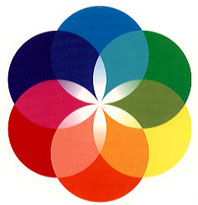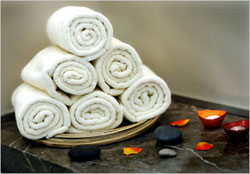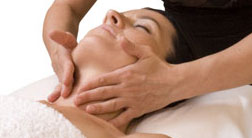
Click on a listing to read more.

Acupressure Acupressure is an ancient form of healing believed by some to be even older than acupuncture. It involves the use of the fingers (and in some cases, the toes) to press key points on the surface of the skin to stimulate the body's natural ability to heal itself. Pressing on these points relieves muscle tension, which promotes the circulation of blood and qi (pronounced "chee") -- the vital energy or "life force" -- to aid in the healing process. Acupressure and acupuncture are somewhat similar. Acupressure is sometimes referred to as "needleless acupuncture," because both forms of healing use the same points to achieve the desired results. The main difference is that an acupuncturist stimulates points by inserting needles, whereas an acupressurist stimulates the same points using finger pressure. Stimulating specific points on the body can trigger the release of endorphins (chemicals produced by the body that relieve pain). When endorphins are released, pain is blocked, and the flow of blood and oxygen to the affected area is increased. This causes the muscles to relax and promotes healing. In acupressure, as with most traditional Chinese medicine concepts, local symptoms are considered an expression of the whole body's condition. When performed correctly, acupressure increases circulation, reduces tension and enables the body to relax. Reducing tension, in turn, strengthens the immune system and promotes wellness. However, applying acupressure too abruptly, or using too much force during treatment, can lead to bruising and discomfort. Great care should be used when applying pressure to points on or near the abdomen, groin, armpits or throat. Special care should be when treating pegnant women or those with recently-formed scars, burns, infections or skin lesions. Aromatherapy Many essential oils that are derived from plants, herbs, flowers, and roots have beneficial therapeutic qualities. Aromatherapy involves the "burning" of essential oils to elicit a desired effect; for example, lavendar is known to induce calmness and relaxation. When combined with bodywork, aromatherapy can enrich the massage experience immensely. A few drops of essential oil can be added to massage cream or oil and applied to the skin. Professionally trained aromatherapists also blend oils to treat specific conditions. Only experienced professionals and/or those knowledable in the properties of aromatherapy should attempt to blend oils or utilize them in practice, as some oil combinations can be toxic, while others can burn the skin. 
Color Therapy Color therapy is a form of energy work based on the theory that light deprivation leads to dysfunction in the body. Since each color has its own frequency and vibration, specific colors are used to treat designated parts of the body. The body, in turn, responds to the vibrational pattern of the color and works to correct the dysfunction. Usui Reiki While not strictly under the auspices of massage, Reiki (pronounced "ray-key") is often practiced in conjunction with bodywork. The word Reiki comes from two Japanese words - rei, meaning higher power or universal force, and ki, meaning life energy. Loosely translated, Reiki means universal or spiritually-guided life-force energy.
CranioSacral Therapy CranioSacral Therapy was developed over 20 years ago by Dr. John Upledger, while he served as a researcher and professor at Michigan State University. This gentle, hands-on technique involves the craniosacral system -- a system of the body composed of membranes and cerebrospinal fluid that surrounds the brain and spinal cord. Practitioners utilize CST to loosen and release restrictions or "blockages" in the body that can contribute to pain and dysfunction; removing such blockages improves the functioning of the central nervous system and body as a whole. CST is effective at treating a number of problems, including pain, headaches, central nervous system disorders, chronic fatigue syndrome, stress, tension and more. Proponents of CST also claim that it aids in improving mental clarity and emotional well-being. Sports Massage Sports massage therapies are both preventative and therapeutic, and used for athletes during warm ups, training and competition to treat and/or aid in the prevention of injuries; help improve flexibility, range of motion, and performance; and aid in mental clarity. Virtually every professional sports team employs professional sports massage therapists, and are often privately employed by professional athletes.
Tot-Sage This is gentle and therapeautic massage for little ones, tweens and teens. Totsage is highly beneficial for growing pains and budding athletes sore muscles. We use only 100% pure oils and lotions. Hydrotherapy Typically, Hydrotherapy involves the use of water in all its forms (internally and externally) to assist in the healing process. These water therapies can include the use of a whirlpool, the application of ice or heat packs, colonic irrigation, steambaths, body wraps and more. In our office we use ice, heat packs, hot towels and hot and cold rock therapy. 
Trigger Point Therapy Trigger points are areas of soft tissue in the body characterized by local pain, tightness, and tenderness. Often trigger points develop because of referred pain, or pain from another source that has manifested itself in a trigger point. Trigger points rarely refer pain to other areas. 
Trigger-point therapy seeks first to identify trigger points, then apply steady, appropriate pressure to the point to "release" it. This is usually followed by massage to the surrounding area to help treat the cause of the trigger point. Clients are encouraged to drink a lot of water following a trigger-point therapy session to flush out any toxins released when the trigger point is released. Medical Massage Practitioners of medical massage have a strong background in pathology, disease, illness and injury, and the contraindications of specific massage techniques related to various medical conditions. Medical massage therapists frequently work under the direction of or at the request of physicians. Neuromuscular Therapy NMT is massage applied to specific muscles, often used to increase blood flow, release knots of muscle tension, or release pain/pressure on nerves. This therapy is also known as trigger-point therapy in that concentrated finger pressure is applied to "trigger points" to alleviate muscular pain. Deep Tissue Massage Deep-tissue massage utilizes slow strokes, direct pressure or friction applied across the grain of the muscles with the fingers, thumbs or elbows. Deep-tissue massage works deeply into the muscles and connective tissue to release chronic aches and pains; its purpose is to reach the fascia beneath the surface muscles. Practitioners must have a thorough understanding of the human body and have been trained to administer deep-tissue massage, as injury can occur if the technique is not performed properly. This technique is useful in treating chronic pain, inflammation and injury. 
Manual Lymph Massage Developed by French physician Bruno Chikly, this technique involves the application of light, rhythmic strokes to help alleviate various conditions related to the body's lymph system. Among other things, the lymph system is responsible for flushing out toxins and draining fluid, which supports a healthy immune system. When lymph circulation stagnates, however, fluid can build up and cause physical problems, such as inflammation, edemas and neuropathies. 
LDT enables practitioners to restore proper lymph flow by using a "mapping" system to assess congested areas in the body, then apply gentle, pressure using the fingers and hands on these areas to reactivate proper circulation. |